Laptop Mag Verdict
The Asus ROG Strix GL553VD is a budget gaming system that will play games on medium settings and has a comfy keyboard, but its weak speakers and poor battery life leave more to be desired.
Pros
- +
Vivid display; Comfortable, RGB-backlit keyboard; Useful software
Cons
- -
Fussy touchpad; Lackluster speakers; Poor battery life
Why you can trust Laptop Mag
You don't have to drop $2,000 on a laptop to play games, but you definitely get what you pay for. The $1,099 Asus ROG Strix GL553VD features Nvidia's entry-level GTX 1050 GPU, which will let you play most games on medium settings. It's also one of Asus' first laptops with an RGB-backlit keyboard, which happens to be really comfortable. But its speakers are lackluster, and it has shorter-than-average battery life. It's the least-expensive option we've reviewed with a Pascal-based GPU, but for the price, you'll have to make some compromises.
Design
Who said that orange is the new black? The Strix gives you both colors, and it isn't exactly a looker. Between its black-plastic chassis and bright-orange accents, Asus' laptop looks like it's ready for Halloween. The lid features two traffic-cone-orange stripes flanking the ROG logo, which is a bit extreme for my taste. When I lifted the lid, the 15.6-inch, 1080p display and the RGB-backlit keyboard were revealed. There are a few more orange accents throughout, including another ROG logo on the palm rest, a ring around the touchpad and the laptop's rubber feet.
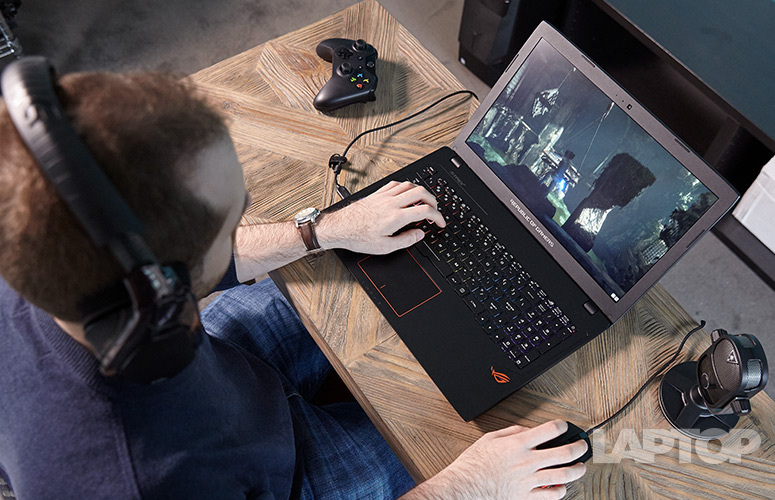
At 5.6 pounds and 15.1 x 10 x 1.2 inches, the laptop is easy to carry around and jam into a backpack to game on the go. The MSI GS63VR 6RF Stealth Pro is both lighter and slimmer, at 4.2 pounds and 14.9 x 9.8 x 0.7 inches. Unsurprisingly, the 17-inch Alienware R3 is heavier (8.3 pounds) and has a much larger footprint, at 16.9 x 11.5 x 1.4 inches.
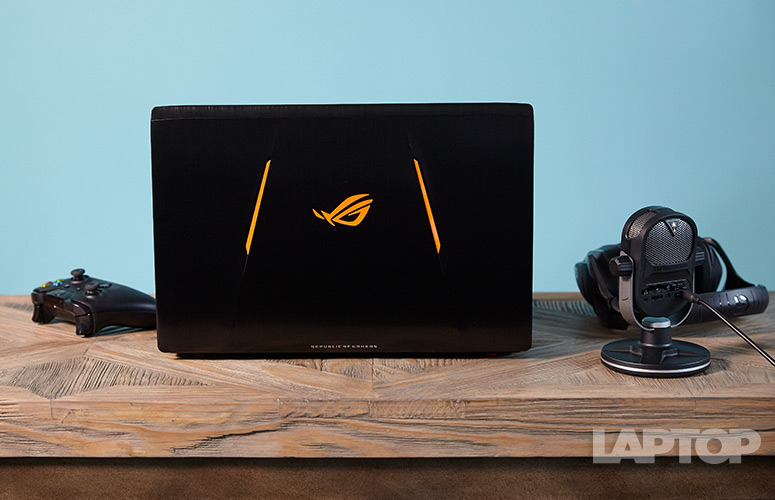
The sides of the Strix are lined with ports for expansion and networking. On the left, you'll find an Ethernet jack, HDMI output, two USB 3.0 ports, a USB Type-C port and a headphone jack. The right side is sparser, with a sole USB 2.0 port, a DVD drive and a Kensington lock slot. An SD card reader is located beneath the palm rest.
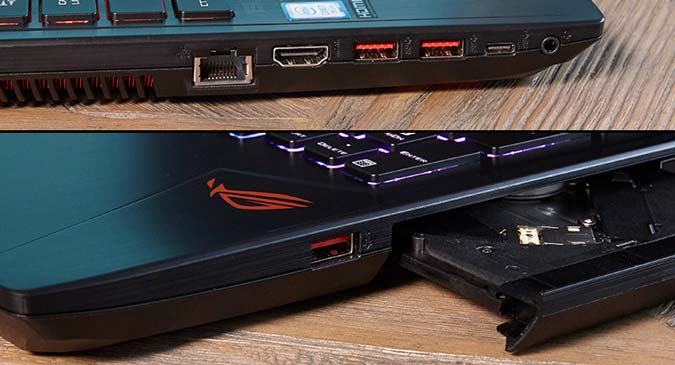
Display
The 15.6-inch, 1080p screen on the Strix is sharp and colorful. When I watched a full-HD trailer for Spider-Man: Homecoming, the red in Spidey's suit was the perfect shade of crimson and the blue was nice and deep, while the fur in the villainous Vulture's collar was nice and sharp.
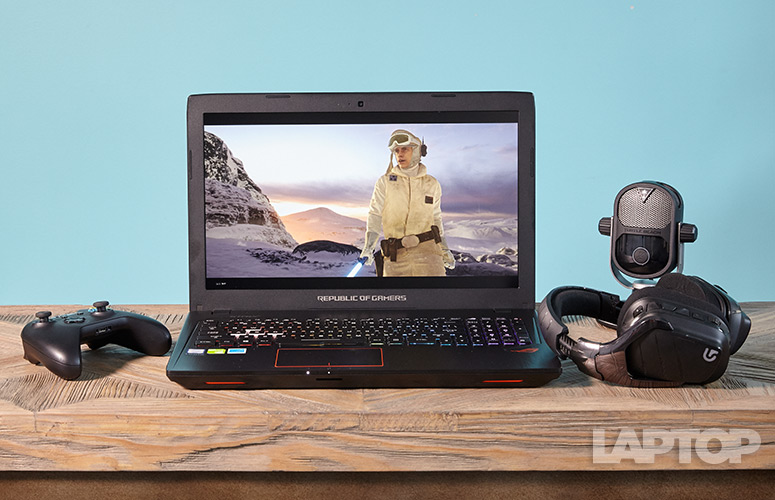
When I played Grand Theft Auto V, the bright-red warning lights bathed the scene of an early bank heist in an eerie glow as Trevor and Michael attempted to blast their way through a battalion of cops. Details were crisp enough during the barrage of bullets that I could make out little creases in a security guard's shirt.
The display reproduces an excellent 122 percent of the sRGB color gamut, far surpassing the mainstream-notebook average (91 percent). The Stealth Pro was slightly less colorful (111 percent), while the Alienware was even richer, at 174 percent.
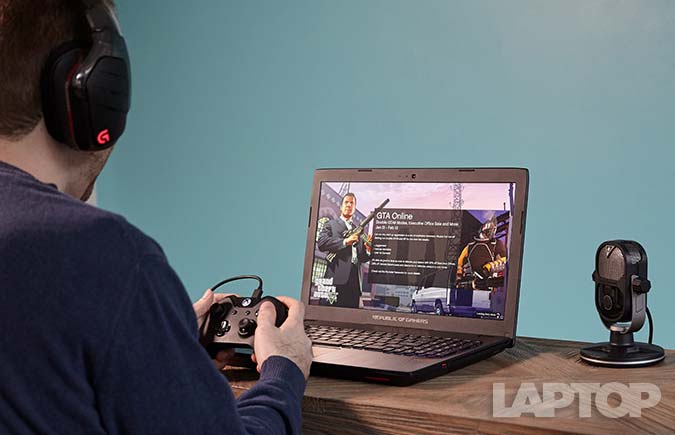
Although the colors are vibrant, they aren't necessarily accurate. The Strix has a Delta-E color accuracy score of 1.6 (0 is best). That's better than the average (2.6) and the Stealth Pro (2), but the Alienware had the best score of the bunch, at 0.8.
The Strix's screen reached 269 nits of average brightness on our light meter, making it a bit better than the 267-nit average and the Stealth Pro (242 nits). However, the Alienware outshined the competition with its 319-nit display.
Keyboard and Touchpad
The keyboard on the Strix is extremely comfortable. Thanks to its deep 2 millimeters of travel and 62 grams of required force to depress the keys, I never found myself bottoming out on the keyboard deck. On the 10fastfingers.com typing test, I cruised along at 115 words per minute (the high end of my average range) and my usual 2 percent error rate. My only complaint is that I wish the keys would pop up faster and with more force, which would be especially useful for gaming.
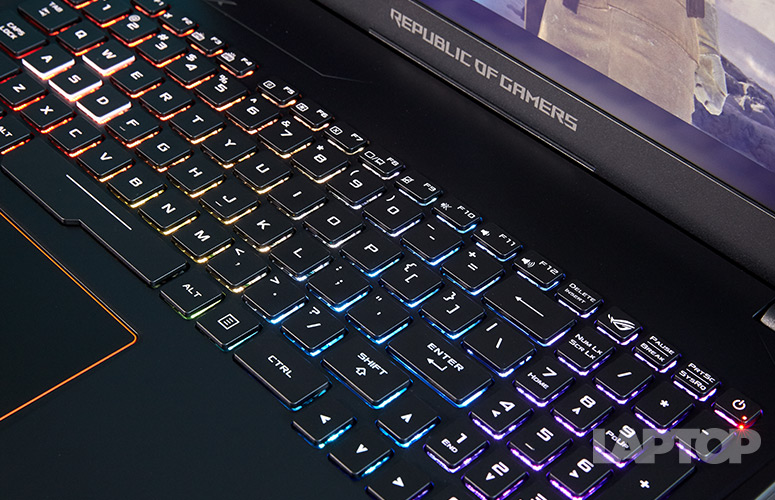
If the keyboard looks more colorful than you're used to, it's because this Strix is one of Asus' first gaming laptops to boast RGB backlighting. You can customize the lighting in the ROG Aura Core app, which lets you assign different colors to four different zones. I wish it went even further, as it would be nice to customize every single key on its own. I also wouldn't mind being able to assign macros, but the software only supports the backlighting.
MORE: Best Asus Laptops
The 4.1 x 2-inch touchpad is overly fussy, so you might want to use a gaming mouse when browsing the web. It's fine for navigating and performing Windows 10 gestures, but it only let me right click in the very-bottom-right corner of the touchpad (just like its 17-inch cousin), while it usually (but not always) would let me left click just about anywhere.
Audio
The speakers on the Strix are serviceable, but the sound quality isn't up to par. When I listened to Blink-182's "Wishing Well," the sound filled our lab, but the only parts I could make out clearly were the vocals and guitars. I had to strain to hear the bass, and the usually impressive percussion was weak in the background.
I was able to do a little fine-tuning, however, thanks to the preinstalled ICEpower AudioWizard software. Switching from multimedia to action added a bit more volume and punch to the drums, though the bass was still lost in the shuffle.
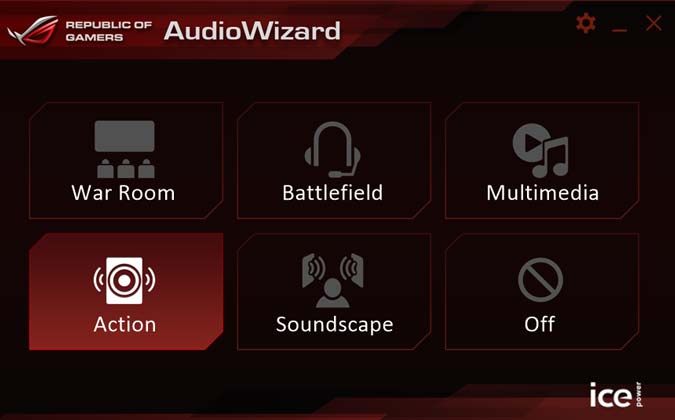
When I played Grand Theft Auto V, I found the game to be on the quiet side. While the characters' voices and gunshots were loud, background music was extremely subdued.
Gaming and Graphics
You're not going to play games at their highest settings on the Strix, but its Nvidia GeForce GTX 1050 GPU with 4GB of VRAM will handle most titles on normal or medium settings. When I played Grand Theft Auto V on high settings, I saw frame rates between 33 and 37 fps, which is above our 30-fps playability threshold, but there was quite a bit of screen tearing. When I bumped the settings down to normal, it hovered between 35 and 39 fps with far less tearing (except for a shoot-out with the police, which dropped the frame rate to between 29 and 30 fps).
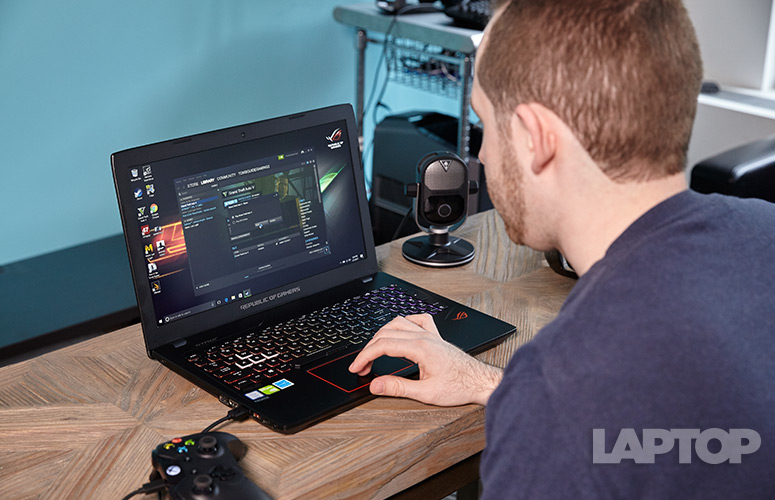
On our budget gaming test, which runs Rise of the Tomb Raider at the High preset with SMAA anti-aliasing, the Strix hit 38 fps. The 1050 Ti configuration (see Configurations section below) ran at a smoother 47 fps.
The Strix ran Metro: Last Light on high at 1080p at 23 fps (28 fps with the 1050 Ti configuration; both are below our 30-fps playability threshold). The mainstream notebook average is 31 fps; the Stealth (Nvidia GeForce GTX 1060 GPU) played the game at 45 fps, and the Alienware (Nvidia GeForce GTX 980M) reached 37 fps.
MORE: The Best Gaming Laptops
The Strix managed to play Hitman on ultra settings at 30 fps. (The 1050 Ti model reached 39 fps.) The average is 57 fps, and the Stealth Pro hit 58 fps.
You won't be able to play VR games with the GTX 1050 version of the Strix. However, the GTX 1050 Ti model meets the minimum standards for the Oculus Rift. Own an HTC Vive? You're going to want to pick up a laptop with an Nvidia GTX 1060, 1070 or 1080 GPU.
Performance
Armed with a 2.8-GHz 7th-gen Intel Core i7-7700HQ CPU; 16GB of RAM; and a 1TB, 7,200-rpm HDD, the Strix is a fine multitasking machine. I had 28 tabs open in Google Chrome, two of which were streaming games from Twitch at high resolution, and I saw only the faintest hint of lag when switching among websites.
On the Geekbench 3 overall performance benchmark, the Strix notched a score of 13,765, beating the mainstream-notebook average (8,277) and the Stealth Pro (Intel Core i7-6700HQ; 13,454). However, it fell just shy of the Alienware (Intel Core i7-6820HK; 13,906).
The Strix is a fine multitasking machine
It took the Strix 54 seconds to copy 4.97GB of mixed media files, which translates to a rate of 94.2 megabytes per second. That's not as fast as the average (162.8 MBps) and doesn't touch the Stealth Pro (565.5 MBps) or the Alienware (509 MBps), both of which use solid-state drives in addition to hard drives.
The Strix completed our OpenOffice Spreadsheet Macro test, in which it matches 20,000 names and addresses, in 3 minutes and 31 seconds, beating the 4:21 average.The Stealth Pro was a little slower, at 3:38, and the Alienware trailed behind, finishing in 3:53.
Battery Life
You'll want to bring a power adapter with you if you take the Strix anywhere. The laptop lasted only 3 hours and 41 minutes on the Laptop Mag Battery Test, which consists of continuous web browsing over Wi-Fi. The average mainstream notebook lasts 6:31. The Alienware 17 R3 endured for 6:07, and the Stealth Pro was the worst of the bunch, at 2:54.
MORE: Laptops with the Longest Battery Life
Webcam
Get an external webcam. The 720p camera on the Strix takes blurry photos. Sure, the colors are accurate, but every shot I took was out of focus, and my face looked as if someone had thrown a lunch tray at it. In the photos, my eyes appeared darker than in real life, my beard seemed drawn on and my hair looked muddled.

Heat
The Strix stayed cool under pressure. After we streamed HD video from YouTube for 15 minutes, the bottom of the laptop reached 93 degrees Fahrenheit, and both the center of the keyboard and the touchpad reached 88 degrees, all of which are below our 95-degree comfort threshold.
However, after I played Grand Theft Auto V, the system got a tad hotter. Both the keyboard and the touchpad reached 93 degrees, and the bottom of the notebook hit a toasty 109 degrees.
Software and Warranty
Asus preloaded the Strix with a variety of useful gaming software. Most notable is the ROG Gaming Center, the go-to spot for everything affecting performance, including temperature and CPU and GPU memory. It also includes options to boost fan speeds and disable the Windows key while gaming. Another gaming program, GameFirst IV, lets you prioritize programs and games' access to your network to reduce lag while you play.
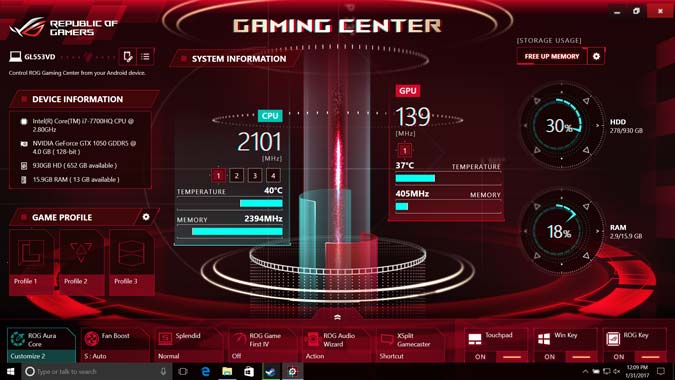
Asus' Splendid utility lets you control color temperature, and the preloaded XSplit Gamecaster allows for Twitch streaming.
There's quite a bit of bloatware, though, including Candy Crush Soda Saga, Royal Revolt II, Minecraft, Netflix, Drawboard PDF and Twitter.
Asus sells the ROG Strix GL553 with a one-year warranty. See how the company did on our Tech Support Showdown and Best and Worst Brands rating.
Configuration
The Asus ROG Strix GL553VD we tested cost $1,099 and included a 2.8-GHz Intel Core i7-7700HQ CPU; an Nvidia GeForce GTX 1050 GPU with 4GB of VRAM; 16GB of RAM; and a 1TB, 7,200 rpm HDD.
Asus sells another model that bumps the GPU up to a GTX 1050 Ti and adds a 256GB SSD for a total of $1,299.
Bottom Line
The $1,099 Asus ROG Strix GL553 is the most affordable gaming laptop that the company currently sells, and it comes with a comfortable keyboard, a vivid display and an Nvidia GTX 1050 GPU. But the laptop's subpar speakers and finicky touchpad are serious trade-offs.
Even though the base model of the Strix is $1,099, we know there are gaming notebooks with 1050 and 1050 TI GPUs and Kaby Lake CPUs coming this year for less than a thousand bucks. (We went hands-on with the Acer Aspire VX15 and the Dell Inspiron 15 7000 Gaming at CES.) Those machines will likely end up being better deals.
However, if you want an affordable gaming laptop that can play the latest games at medium settings, the Strix is a good option.
Photo credit: Jeremy Lips/Laptop Mag
Asus ROG Strix GL553VD Specs
| Bluetooth | Bluetooth 4.0 |
| Brand | ASUS |
| CPU | 2.8-GHz Intel Core i7-7700HQ CPU |
| Card Slots | SD memory reader |
| Company Website | asus.com |
| Display Size | 15.6 |
| Graphics Card | Nvidia GeForce GTX 1050 (4GB) Intel HD Graphics 630 |
| Hard Drive Size | 1 TB |
| Hard Drive Speed | 7,200rpm |
| Highest Available Resolution | 1920 x 1080 |
| Native Resolution | 1920x1080 |
| Operating System | Windows 10 Home |
| Optical Drive | CD Burner/DVD Combo Drive |
| Optical Drive Speed | 8X |
| Ports (excluding USB) | Ethernet, HDMI-out, USB 3.0, Kensington Lock, USB Type-C, Combo Headphone/Mic Jack |
| RAM | 16GB |
| RAM Upgradable to | 32GB |
| Size | 5.6 pounds |
| Touchpad Size | 4.1 x 2 inches |
| USB Ports | 4 |
| Video Memory | 4GB |
| Warranty/Support | 1-year |
| Weight | 15.1 x 10 x 1.2-inches |
| Wi-Fi | 802.11ac |
| Wi-Fi Model | Intel 2x2 802.11ac |
